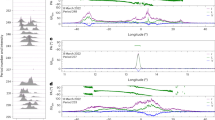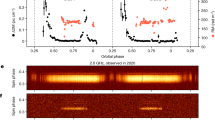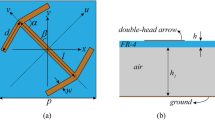Abstract
IN a recent article, Radhakrishnan et al.1 commented on the remarkably constant intensity of pulsar PSR 0833–45 at 1,720 and 2,700 MHz. At these frequencies intensity values, averaged over 100 pulses and taken at any tune over several days of observation in December 1968, showed less than 10 per cent variation. Large et al.2 have noticed similar behaviour at 408 MHz. This property of the signal, in fact, greatly facilitated the taking of the polarization measurements which were the main subject of the article by Radhakrishnan et al.
This is a preview of subscription content, access via your institution
Access options
Subscribe to this journal
Receive 51 print issues and online access
$199.00 per year
only $3.90 per issue
Buy this article
- Purchase on SpringerLink
- Instant access to full article PDF
Prices may be subject to local taxes which are calculated during checkout
Similar content being viewed by others
References
Radhakrishnan, V., Cooke, D. J., Komesaroff, M. M., and Morris, D., Nature, 221, 443 (1969).
Large, M. I., Vaughan, A. E., and Wielebinski, R., Nature, 220, 753 (1968).
Gardner, F. F., and Whiteoak, J. B., Nature (in the press).
Wielebinski, R., Proc. Astron. Soc. Austral., 1, 226 (1969).
Author information
Authors and Affiliations
Rights and permissions
About this article
Cite this article
COOKE, D. Intensity Variations of PSR 0833–45 at 1,720 MHz. Nature 224, 569 (1969). https://doi.org/10.1038/224569a0
Received:
Issue date:
DOI: https://doi.org/10.1038/224569a0



